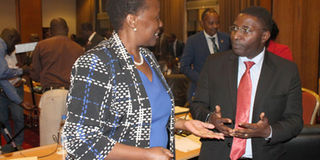Discussions on pipeline to end in June - Muloni

Ms Muloni discuses with her Tanzanian counterpart Dr Kalemani during discussions in Kampala last week. PHOTO BY KELVIN ATUHAIRE
What you need to know:
Concluded. Conclusions of the discussions will be completed in June pending consultations from Presidents John Magufuli and Museveni.
Energy minister Irene Muloni and her Tanzanian counterpart Medard Kalemani have said the two governments and oil companies have committed to conclude discussions and sign the contentious Host Government Agreement (HGA) as well as reaching Final Investment Decision (FID) for the crude oil export pipeline by June.
The two ministers, flanked by their technical teams, also told journalists they have referred some of the contentious items that have held back conclusion of the HGA - which details among others rights and obligations of each of the parties in the Shs13 trillion ($3.55b) pipeline - to their respective presidents for counsel before they can agree.
“There is need for us to have a common understanding on issues of common interest between the two countries,” Ms Muloni said.
The first round of talks on the HGA commenced last April, way behind schedule, followed by the second round in December, and the third round on January 3.
The two countries are reading separate scripts of the HGA - a precursor to other key agreements such as the shareholders agreement, project financing agreement, transportation agreement, and establishment of a pipeline company - which officials said have to be “harmonised” before signing, respectively, with the oil companies - French oil major Total E&P, Anglo-Irish Tullow Oil and China’s CNOOC.
The pipeline company will have Uganda through the Uganda National Pipeline Company and Tanzania through Tanzania Petroleum Development Corporation, and joint venture partners as major shareholders.
Dr Kalemani said the two countries have generally agreed on everything pending consultations with presidents, Tanzania’s John Magufuli and Mr Museveni.
“Our duty is to ensure that all intended agreements are finalised and signed by June this year,” he said, adding: “Generally, the entire project (pipeline) is of mutual interest to us (Uganda and Tanzania) but there are issues that are critical to each party,” he said.
Some of the issues that require harmonisation, Dr Kalemani said, among others include fiscal regime to ensure that “each country benefits to the maximum” and local content.
Sources familiar with the negotiations told Daily Monitor that Tanzania is “playing hard ball” on some of the issues such as fiscal regime because “it’s their only way of gaining from the project”, transporting Uganda’s oil for the oil companies.
However, Ms Muloni said that “once we receive the blessing from the presidents we will have few meetings remaining with the oil companies to finalise the other agreements, and then sign by June.”
The pipeline will run 1,445 kilometres from Hoima in mid-western Uganda, en route to Tanga port on the shores of the Indian Ocean in Tanzania.
The Tanga route was selected on the basis, among other factors, transit fees of $12.2 per barrel (Shs40,321) - which has since been contested and been subject of intense discussions - environmental considerations, flat terrain, limited infrastructure constraints, Tanzania’s convenient land tenure system, and Tanga port being conveniently available for use.
Uganda’s Energy ministry permanent secretary Robert Kasande indicated that related activities such as land acquisition, road mapping, and others, are ongoing.
“In these meetings, we have people from other departments like lands, security, national oil companies, roads, so that if we discuss something on lands, the concerned parties take it up to speed up the process to ensure we don’t repeat ourselves,” Mr Kasande said.
Mobilising tourists
Only 20 per cent - 298km - of the pipeline’s total length is in Uganda: the section is expected to cost $700m (Shs2.4trillion) while 80 per cent, whose capital expenditure is $3.5b will be on the Tanzanian side.
Lands minister Betty Amongi said mapping of the pipeline corridor through the 10 districts -Hoima, Kikuube, Kyankwanzi, Kiboga, Kakumiro, Sssembabule, Gomba, Mubende, Lwengo, and Kyotera - and compilation of a cadastral report have been concluded, and they are now compiling a valuation report for resettlement action plan. “We are looking at a timeline not exceeding March to finish all our activities,” she said.
Uganda is now looking at 2021 to start commercial oil production but industry sources say it could even delay further to 2023 or 2024 because the ongoing discussions for both the upstream - development of the oil fields - and midstream (pipeline and refinery) are likely to drag.




